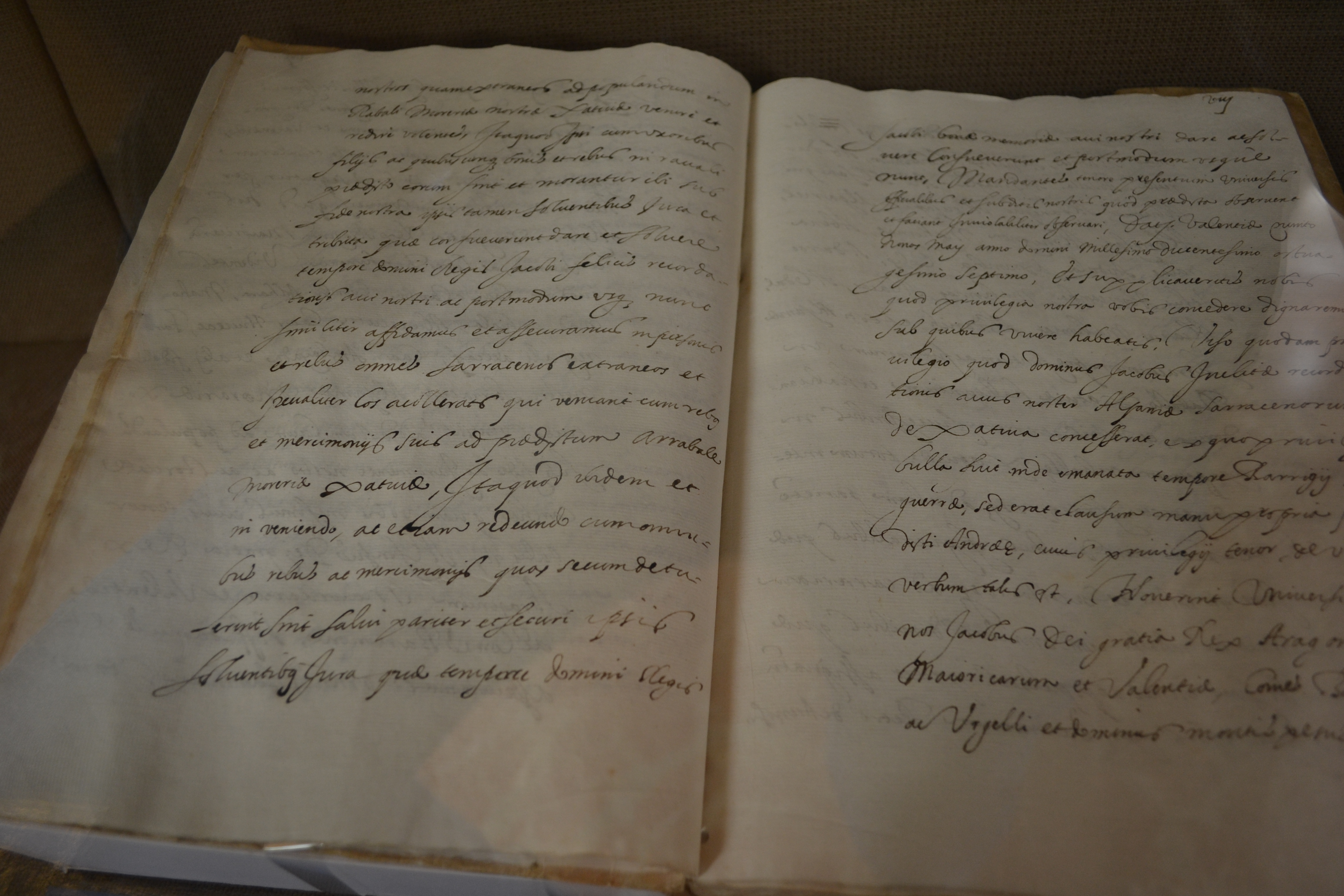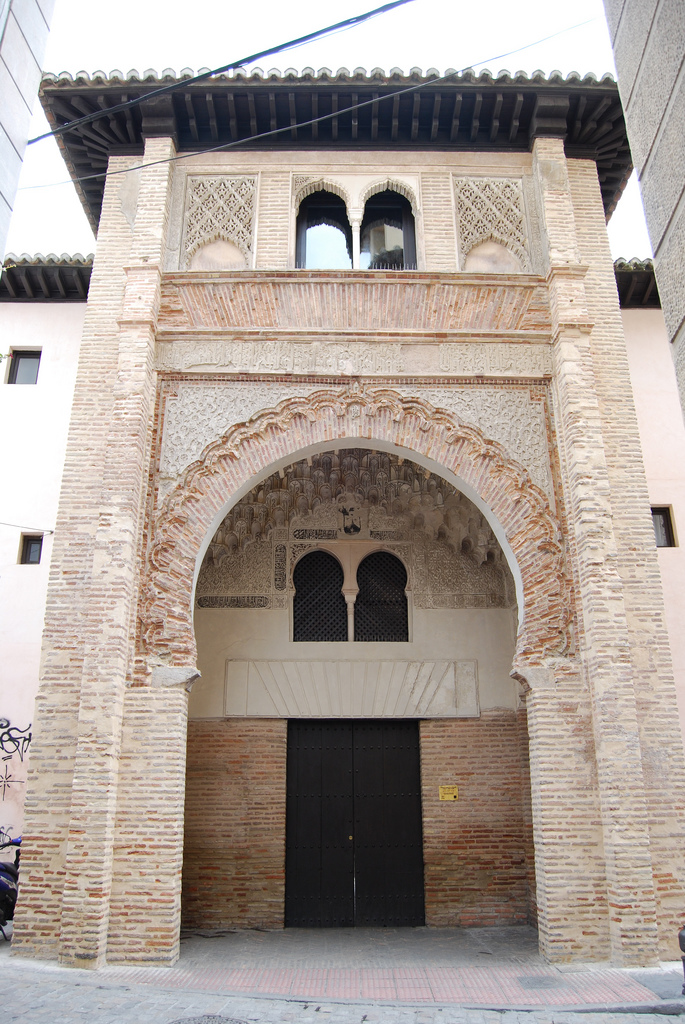|
Alhóndiga (building)
An alhóndiga (from Medieval Spanish ''alfóndiga'', in turn from Arabic ''al-fondaq'', this in turn from Greek ''pandocheion'', lit.: "welcome all") or almudí, almudín, alholí, public house or neighbors' market was formerly an establishment where grain was sold, bought and even stored, whose purpose was to help the neighbors and mainly the farmers in times of shortage. It is historically equivalent or derived from the caravanserais (or ''funduq''s) of the Muslim world. The public almudíes were establishments managed by the city councils where all those who introduced any kind of grain to sell were obliged to carry them with the same object. The almudí was composed of large and spacious warehouses or markets in which various types of grain were conveniently placed. It was open during the day and to this deposit often came many bodies and individuals who wanted to acquire a certain amount of cereals for their needs. Each competitor or holder of grains satisfied by rights a pr ... [...More Info...] [...Related Items...] OR: [Wikipedia] [Google] [Baidu] |
Old Spanish
Old Spanish, also known as Old Castilian ( es, castellano antiguo; osp, romance castellano ), or Medieval Spanish ( es, español medieval), was originally a dialect of Vulgar Latin spoken in the former provinces of the Roman Empire that provided the root for the early form of the Spanish language that was spoken on the Iberian Peninsula from the 10th century until roughly the beginning of the 15th century, before a ''consonantal readjustment'' gave rise to the evolution of modern Spanish. The poem ('The Poem of the Cid'), published around 1200, is the best known and most extensive work of literature in Old Spanish. Phonology The phonological system of Old Spanish was quite similar to that of other medieval Romance languages. Sibilants Among the consonants, there were seven sibilants, including three sets of voiceless/voiced pairs: *Voiceless alveolar affricate : represented by before , , , and by before or *Voiced alveolar affricate : represented by *Voiceless apicoa ... [...More Info...] [...Related Items...] OR: [Wikipedia] [Google] [Baidu] |
Morelia
Morelia (; from 1545 to 1828 known as Valladolid) is a city and municipal seat of the municipality of Morelia in the north-central part of the state of Michoacán in central Mexico. The city is in the Guayangareo Valley and is the capital and largest city of the state. The main pre-Hispanic cultures here were the Purépecha and the Matlatzinca, but no major cities were founded in the valley during this time. The Spanish took control of the area in the 1520s. The Spanish under Viceroy Antonio de Mendoza founded a settlement here in 1541 with the name of Valladolid, which became rival to the nearby city of Pátzcuaro for dominance in Michoacán. In 1580, this rivalry ended in Valladolid's favor and it became the capital of the viceregal province. After the Mexican War of Independence, the city was renamed Morelia in honor of José María Morelos, who hailed from the city. In 1991, the city was declared a UNESCO World Heritage Site for its well-preserved historical buildings and layo ... [...More Info...] [...Related Items...] OR: [Wikipedia] [Google] [Baidu] |
Mexico City
Mexico City ( es, link=no, Ciudad de México, ; abbr.: CDMX; Nahuatl: ''Altepetl Mexico'') is the capital and largest city of Mexico, and the most populous city in North America. One of the world's alpha cities, it is located in the Valley of Mexico within the high Mexican central plateau, at an altitude of . The city has 16 boroughs or ''demarcaciones territoriales'', which are in turn divided into neighborhoods or ''colonias''. The 2020 population for the city proper was 9,209,944, with a land area of . According to the most recent definition agreed upon by the federal and state governments, the population of Greater Mexico City is 21,804,515, which makes it the sixth-largest metropolitan area in the world, the second-largest urban agglomeration in the Western Hemisphere (behind São Paulo, Brazil), and the largest Spanish language, Spanish-speaking city (city proper) in the world. Greater Mexico City has a gross domestic product, GDP of $411 billion in 2011, which makes ... [...More Info...] [...Related Items...] OR: [Wikipedia] [Google] [Baidu] |
Xàtiva
Xàtiva (, es, Játiva ) is a town in eastern Spain, in the province of Valencia, on the right (western) bank of the river Albaida and at the junction of the Valencia–Murcia and Valencia Albacete railways. It is located 25 km west of the Mediterranean Sea. During the Al-Andalus Islamic era, Arabs brought the technology to manufacture paper to Xàtiva. In the 12th century, Xàtiva was known for its schools, education, and learning circles. Islamic scholar Abu Ishaq al-Shatibi's last name refers to Xàtiva where he lived and died. After the Reconquista by Northern Christian kingdoms and the following Christian repopulation, the city became the cradle of one of the most powerful and controversial families of the Renaissance, the House of Borgia, which produced Popes like Callixtus III (Alfonso de Borgia) and Alexander VI (Rodrigo de Borgia). History Xàtiva (''Saetabis'' in Latin) was famous in Roman times for its linen fabrics, mentioned by the Latin poets Ovid and C ... [...More Info...] [...Related Items...] OR: [Wikipedia] [Google] [Baidu] |
Guanajuato City
Guanajuato () is a city and municipal seat of the municipality of Guanajuato in central Mexico and the capital of the state of the same name. It is part of the macroregion of the Bajío. It is in a narrow valley, which makes its streets narrow and winding. Most are alleys that cars cannot pass through, and some are long sets of stairs up the mountainsides. Many of the city's thoroughfares are partially or fully underground. The historic center has numerous small plazas and colonial-era mansions, churches, and civil constructions built using pink or green sandstone. The city historic center and the adjacent mines were proclaimed a World Heritage Site by UNESCO in 1988. The growth of Guanajuato resulted from the abundantly available minerals in the mountains surrounding it. The mines were so rich that the city was one of the most influential during the colonial period. One of the mines, La Valenciana, accounted for two-thirds of the world's silver production at the height of its pr ... [...More Info...] [...Related Items...] OR: [Wikipedia] [Google] [Baidu] |
Alhóndiga De Granaditas
The Alhóndiga de Granaditas (Regional Museum of Guanajuato) ( public grain exchange) is an old grain storage building in Guanajuato City, Mexico. This historic building was created to replace an old grain exchange near the city's river. The name Alhóndiga translates roughly from both Arabic and Spanish as grain market or warehouse. It is equivalent to the regional grain exchange. Its construction lasted from 1798 to 1809, by orders of Juan Antonio de Riaño y Bárcena, a Spaniard who was the quartermaster of the city during the Viceroyalty of New Spain. Miguel Hidalgo y Costilla helped build it. The building received World Heritage listing as part of the Historic Town of Guanajuato in 1988. Architecture The Grain Exchange is an example of Neoclassical ideas. The original design was drafted in 1796 by Josė Alejandro Durán y Villaseñor, who was the master of public works. Josė de Mazo y Avilés modified the plans later. It measures 72 by 68 metres, with a height of 23 me ... [...More Info...] [...Related Items...] OR: [Wikipedia] [Google] [Baidu] |
Granada
Granada (,, DIN 31635, DIN: ; grc, Ἐλιβύργη, Elibýrgē; la, Illiberis or . ) is the capital city of the province of Granada, in the autonomous communities of Spain, autonomous community of Andalusia, Spain. Granada is located at the foot of the Sierra Nevada (Spain), Sierra Nevada mountains, at the confluence of four rivers, the Darro (river), Darro, the Genil, the Monachil (river), Monachil and the Beiro. Ascribed to the Vega de Granada ''comarca'', the city sits at an average elevation of Above mean sea level, above sea level, yet is only one hour by car from the Mediterranean coast, the Costa Tropical. Nearby is the Sierra Nevada Ski Station, where the FIS Alpine World Ski Championships 1996 were held. In the 2021 national census, the population of the city of Granada proper was 227,383, and the population of the entire municipal area was estimated to be 231,775, ranking as the Ranked lists of Spanish municipalities, 20th-largest urban area of Spain. About 3.3% of t ... [...More Info...] [...Related Items...] OR: [Wikipedia] [Google] [Baidu] |
Corral Del Carbón
The Corral del Carbón, originally al-Funduq al-Jadida, is a 14th-century historic building in the Spanish city of Granada (Andalusia). It is the only Nasrid ''alhóndiga'' or ''funduq'' (a commercial warehouse or inn) preserved in the Iberian peninsula. The building is located south of the Albaicin quarter, near the present-day Cathedral (formerly the city's Great Mosque). History The building dates from the Nasrid period but the exact date of its construction is not known. It is believed to be from the early 14th century, before 1336 (when it is mentioned in some historical documents). Its original name was ''al-Funduq al-Jadida'' or "the New Inn/Warehouse". Like other urban caravanserais (known as ''funduq''s in al-Andalus and Morocco) at that time, it was a commercial and trading center serving as a warehouse for grain and as an inn and storage facility for merchants from outside the city. The existence of caravanserais can be traced in part from the Greek ''pandocheion ... [...More Info...] [...Related Items...] OR: [Wikipedia] [Google] [Baidu] |
Cuenca, Spain
Cuenca () is a city and municipality of Spain located in the autonomous community of Castilla–La Mancha. It is the capital of the province of Cuenca. Etymology Its name may derive from the Latin ''conca'' meaning "river basin", referring to the gorge of the rivers Júcar and Huécar. It may also be derived from the now-ruined Arab castle, Kunka. Other alternative original names have been suggested, including "Anitorgis", "Sucro" or "Concava". The city of Cuenca is also known as the "Eagle's Nest" because of its precarious position on the edge of a gorge. History When the Iberian peninsula was part of the Roman Empire, there were several important settlements in the province, such as Segobriga, Ercavica and Gran Valeria. However, the place where Cuenca is located today was uninhabited at that time. When the Muslims captured the area in 714, they soon realized the value of this strategic location and they built a fortress (called ''Kunka'') between two gorges dug between ... [...More Info...] [...Related Items...] OR: [Wikipedia] [Google] [Baidu] |
Alhóndiga (Cuenca)
Alhóndiga is a municipality located in the province of Guadalajara, Spain. According to the 2004 census (INE INE, Ine or ine may refer to: Institutions * Institut für Nukleare Entsorgung, a German nuclear research center * Instituto Nacional de Estadística (other) * Instituto Nacional de Estatística (other) * Instituto Nacional Elec ...), the municipality has a population of 244 inhabitants. References {{DEFAULTSORT:Alhondiga Municipalities in the Province of Guadalajara ... [...More Info...] [...Related Items...] OR: [Wikipedia] [Google] [Baidu] |
Bilbao
) , motto = , image_map = , mapsize = 275 px , map_caption = Interactive map outlining Bilbao , pushpin_map = Spain Basque Country#Spain#Europe , pushpin_map_caption = Location within Basque Country##Location within Spain##Location within Europe , pushpin_relief = yes , subdivision_type = Country , subdivision_name = , subdivision_type1 = Autonomous community , subdivision_name1 = Basque Country , subdivision_type2 = Province , subdivision_name2 = Biscay , subdivision_type3 = Comarca , subdivision_name3 = Greater Bilbao , seat_type = , seat = , coordinates = , coordinates_footnotes = , elevation_m = 19 , elevation_min_m = 0 , elevation_max_m = 689 , area_footnotes = , area_total_km2 = 41.50 , area_urban_km2 = 18.22 , ar ... [...More Info...] [...Related Items...] OR: [Wikipedia] [Google] [Baidu] |



.jpg)

_Cuenca.png)